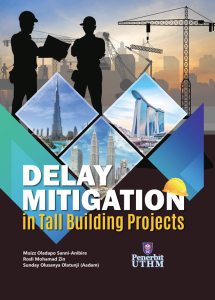Delay Mitigation in Tall Building Projects
Synopsis
The rise of tall buildings in urban centres across the globe has been attributed to the need to create more urban space for an imminent population explosion and urbanization crisis. Despite the potential of this building typology as a sustainable alternative to urban design, it has become notorious for being delayed, and sometimes abandoned. The research domain is saturated with numerous studies on the causes of construction delays, however inadequate effort has been channelled towards the development of prescriptive tools with the potential to mitigate construction delay. The desired solution is one that would employ innovative methods to arrive at problem solving strategies for the ultimate purpose of delay mitigation. Today, the fourth industrial revolution (IR 4.0) offers the construction industry a unique opportunity to solve its many woes, such as delays, through leveraging the capabilities of digital technologies such as artificial intelligence and machine learning. Thus, it is the purpose of this book to describe a delay mitigation framework proposed for tall building projects based on the application of machine learning. The application of machine learning is considered in three major areas of project delay risk mitigation including “reliable cost estimates”, “reliable duration estimates”, and “delay risk assessment”. Interestingly, the concept of the delay mitigation framework can be extended to other project types, besides tall building projects.
Downloads
References
Abdullah, M. R., Azis, A. A., & Rahman, I. A. (2009). Potential effects on large mara construction projects due to construction delay. International Journal of Integrated Engineering, 1(2).
Banobi, E. T., & Jung, W. (2019). Causes and Mitigation Strategies of Delay in Power Construction Projects: Gaps between Owners and Contractors in Successful and Unsuccessful Projects. Sustainability, 11(21), 5973.
Canziani, A., Paszke, A., & Culurciello, E. (2016). An analysis of deep neural network models for practical applications. arXiv preprint arXiv:1605.07678.
Deka, P. C. (2019). A Primer on Machine Learning Applications in Civil Engineering. CRC Press.
Egan, J. (1998). Rethinking construction. Department of Environment, Transport and the Region.
Fallahnejad, M. H. (2013). Delay causes in Iran gas pipeline projects. International Journal of Project Management. Pergamon, 31(1), pp. 136–146.
Galway, L. (2004). Quantitative risk analysis for project management: A critical review. RAND Corporation.
Suksai, S., Moungnoi, W., Charoenpornpattana, S., & Homthong, S. (2015). Delay Factors between Main Contractors and Nominated Subcontractors in High Rise Buildings in Thailand. GSTF Journal of Engineering Technology, 3(3).
Tafazzoli M. & Shrestha P.P., (2017) ‘ Investigating Causes of Delay in U.S. Construction Projects’, 53rd ASC Annual International Conference Proceedings by the Associated Schools of Construction, Seattle, Washington.
Xu, Z., Zayed, T., & Niu, Y. (2020). Comparative analysis of modular construction practices in mainland China, Hong Kong and Singapore. Journal of Cleaner Production, 245, 118861.
Yang, J.B., Yang, C.C. and Kao, C.K. (2010). Evaluating schedule delay causes for private participating public construction works under the Build-Operate-Transfer model. International Journal of Project Management. Pergamon, 28(6), pp. 569–579.




